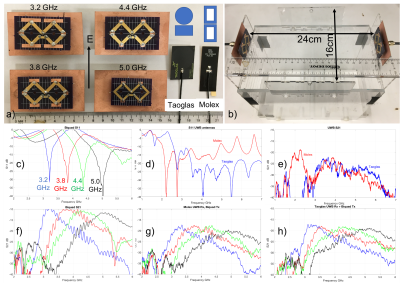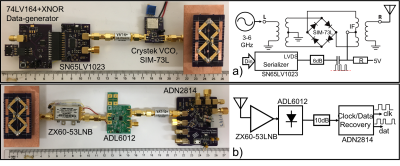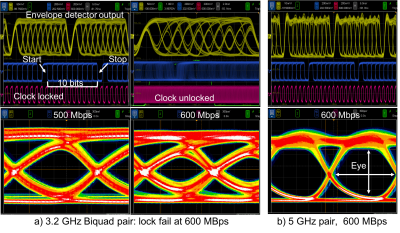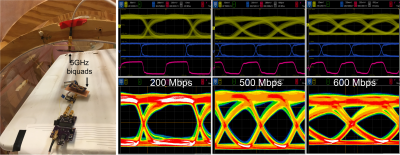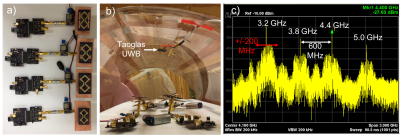4280
High Speed Serial ASK Signal Integrity for Wireless MRI1Electrical Engineering, Stanford University, Stanford, CA, United States, 2Victoria University of Wellington, Wellington, New Zealand, 3Pediatric Radiology, Stanford University, Stanford, CA, United States, 4GE Healthcare, Aurora, OH, United States, 5Stanford University, Stanford, CA, United States, 6Radiology, Stanford University, Stanford, CA, United States
Synopsis
A major challenge of wireless MRI is how to implement the data link. Here, progress is made using amplitude shift keyed diode ring modulators, serializer/deserializer components and clock/data recovery to demonstrate bit rate transmissions up to 600 Mbps. High gain biquad reflector antennas and UWB antennas are compared for carriers between 3 and 5 GHz. These prototypes also demonstrate bandwidth limitations and electrodynamic interactions in a birdcage test bore on wireless signal integrity. Even if dedicated wireless ICs are not possible, we believe components exist to make an easily integrated modulator for MRI wireless data transmission.
Introduction
Modern MRI receive array design is trending towards lighter and wearable arrays, but as channel counts increase, the cabling and balun components remain bulky and impact patient handling. Wireless arrays have been proposed, but to date, wireless standards have failed to make in-roads for the MRI use case. Recent work on mm-wave [1] and simple amplitude or phase shift binary modulation [2] suggest that a custom, very short range but high speed microwave serial link is achievable. However, data rates will depend heavily on bandwidth limits imposed by the antenna and environment. This work begins the development of a realizable signal chain and antenna prototypes to study the high speed signal integrity needs for wireless MRI.Methods
Four biquad antenna [3] pairs (Fig. 1a) were constructed for center frequencies of 3.2, 3.8, 4.4 and 5.0 GHz. Capacitive top-loading and screw-on reflector separation allowed tuning and matching adjustment. In addition, commercial ultra-wideband (UWB) antennas by Taoglas and Molex were assessed. Using the setup of 1b, antenna matching (S11) and propagation link loss S21 were measured at 16cm separation for various antenna combinations.Next, amplitude shift keyed (ASK) modulators and demodulation systems were prototyped (Fig. 2). A 74LV164 and XNOR loopback circuit formed a rudimentary 10-bit pattern generator, using SiTime MEMs oscillators as clock sources. Data was clocked in to a SN65LV1023A 10-bit serializer, whose LVDS output modulated a diode ring mixer. The mixer IF port was DC biased to generate the constant carrier feedthrough needed for amplitude shift keying. Crystek voltage controlled oscillators, with potentiometer frequency adjustment, acted as low power (<3dBm) signal sources. The serializer embedded a clock by adding an extra start bit (1) and stop bit (0), meaning 12 bits are sent per 10 bit word. This scheme precludes easy use of differential phase shift keying (DPSK), but works well with ASK.
The ASK demodulation uses a Mini-Circuits ZX60-53LNB gain stage followed by an ADL6012 envelope detector, the latter specified with 500 MHz bandwidth from 2-67 GHz. Clock and data recovery was performed by an ADN2814 (10-675 Mbps) which includes a limiting amplifier front-end for mV level signal recovery. A deserializer block (SN65LV1224B) was also prototyped (not shown).
Results
Results from Fig. 1c,d provide the matching of the biquad and UWB antennas. From the 16cm path loss plots of 1e-h, each biquad antenna reaches almost -10dB at the cost of bandwidth while the UWB antennas manage about -25 to -30dB but with wide bandwidth. Using a hybrid of biquad and UWB yields the expected compromise in lower gain (~8dB ) but intermediate bandwidth. Figure 3 shows the impact of biquad antenna bandwidth for a 3.2 GHz pair and 5.0 GHz pair. At 3.2 GHz carrier and 500 Mbps, data (blue) is recovered and the start/stop bits are apparent. As bit rate goes to 600 Mbps, the envelope detector output (yellow) degrades, causing loss of clock lock. The corresponding eye plots provide more detail of the signal degradation. At 5 GHz and 600 Mbps, the percentage antenna bandwidth is lower, and bit intervals are well-formed. Figure 4 shows a 5 GHz transmission, in a shielded birdcage test bore using the 5 GHz biquad pair. Now, as bit rates increase from 200 Mbps to 600 Mbps, the reflective environment further impairs the eye patterns, though clock and data recovery is still achieved. More oblique antenna placement can substantively change the signal strength and eye shape.Discussion
These prototypes formed the basis of a 10 bit word-in, word out serial link using as its core, simple ASK modulation of a diode ring mixer, but with repurposed optical CDR and back-plane SERDES components. Electronic modulation rates in excess of 600 Mbps are feasible over the very short link distances needed inside an MRI bore, but the signal integrity with expected wave guiding between patient and shield, among other phenomena, needs more study. This work also provides a paradigm shift in how wireless MRI might be considered - rather than being a wireless networking problem with multi-user mobile considerations such as WiFi, it is better viewed simply as a "through-air" high speed serial I/O interfacing challenge. However multiple channels can still be envisioned. For example, in Fig. 5, a UWB antenna receives four bands of ASK-modulated 200 Mbps patterns with carriers spaced 600 MHz apart. Here, the SINC-like spectra of adjacent channels will still interfere, but a combination of spatial separation and/or antenna polarization might alleviate adjacent channel interference. Moreover, fewer channels can be traded for higher data rates for a given spectral bandwidth. With spectra exceeding 500MHz bandwidth, this approach is really a form of single carrier modulated UWB transmission.Conclusions
We demonstrated that serializer/deserializer (SERDES) components could amplitude-modulate diode ring mixers in excess of 600 Mbps, forming the basis of very short range wireless serial links. A combination of high gain reflector or UWB antennas will support these rates subject to specific antenna bandwidth and propagation limits. The data modulation circuitry can be very simple and compact, while no size limitations exist for the necessarily more complex demodulation electronics. This suggests that wireless MRI technology may not need dedicated IC development at all.Acknowledgements
The authors would like to thank GE Healthcare for research support, and received funding from NIH grants R01 EB019241, U01EB029427, R01EB012031, U01EB026412.References
[1] A Millimeter-Wave Digital Link for Wireless MRI, K Aggarwal et al, IEEE TMI, 36, p574, Feb. 2017.
[2] BPSK/ASK Wireless Link Assessment for MRI, G. Scott et al, Proc 28th ISMRM p759, 2020.
[3] A New Wideband Modified Biquad Antenna at VHF Communication Systems, M Abdolahi et al, 16th Mediterranean Microwave Symposium (MMS) Nov 2016, DOI: 10.1109/MMS.2016.7803873
Figures
